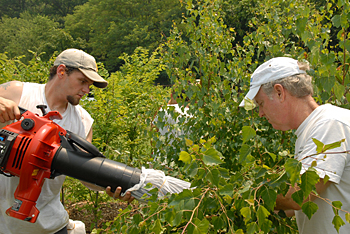
--Mahatma Gandhi
These are the words that UD graduate student Chris Philips said he lived by, as he methodically planted a Norway maple next to a red maple, an English blue holly next to American holly, and a Korean rhododendron next to a pink azalea, on an unseasonably chilly afternoon this past spring.
Now, in the sticky heat of summer, Gandhi's words still seems to run through Philips' head as he pushes a lawn mower in between the rows of shrubs and trees. Despite his maintenance work, this garden wouldn't win any prizes for aesthetics. The 125-foot by 50-foot plot, tucked behind Delaware Stadium and bordered by the UD Woods, is strictly utilitarian in design. There are no garden benches or gazing balls, and a handful of weeds poke up through the mulch.
But Philips' gardening efforts aren't about what the casual observer can see, but what's detected upon closer examination--insects. Philips' work is all about the insects flying about, landing on and, most importantly, feeding on these native and non-native plants that are growing side by side. The garden is the cornerstone of Philips' research project, “The Impact of Alien Plants on Native Insect Herbivores.” The project is being supported by a four-year grant from the National Science Foundation.
Philips, who is conducting this research in conjunction with Doug Tallamy, chairperson of the Department of Entomology and Wildlife Ecology, wants to find out if non-native plants support as many native insects as do plants in the same genus that are native to Delaware. So, Philips must periodically collect samples of insects in the plot. The first sampling occurred in late June; a second will take place in late August. His sampling technique is simple but effective--using a modified leaf blower fitted with a nylon mesh bag, Philips sucks insects off the alien Norway maple, for example, and compares this cache with what he collects off the native red maple.
The analysis focuses on insect biomass--the sheer number of insects on the native plants versus the non-natives, as well as by identification of insect species. Species are categorized by whether they are generalists--thus, eating many different plants--or specialists, who eat only one species of plant or several closely related plants. The researchers want to see if non-native plants affect these two categories of insects differently.
All the detailed analysis and identification occurs in Tallamy's laboratory and can take months to accomplish. But Philips said he finds the work deeply rewarding.
“Insects consistently get a bad rap,” Philips said. “But they play a crucial role in maintaining the integrity of the ecosystem.
“I first learned about Doug's various projects at a professional conference, and I knew then that UD was where I belonged,” Philips said. “I wanted to play a part in research that helps us better understand the complex relationship between insects and plants. Hopefully, the knowledge we gain will prove useful in biodiversity conservation efforts.”
So do alien plants reduce the native insect population? That's the $64,000 question, Tallamy said, in his office located just a short trek from the garden. Preliminary research findings do suggest that alien plant species reduce the population of native insect herbivores, he said. To those who have never appreciated bugs, that may sound like a good thing. Plant a non-native Kousa dogwood and be rewarded with fewer pesky insects than you would if you planted a native dogwood, such as an alternate-leaf dogwood.
But Tallamy stresses that all insects are beneficial (even if they aren't, strictly speaking, beneficial insects). As defined by entomologists, beneficial insects are pollinators, decomposers, predators and parasites whose actions are useful to humankind. Think of the native bee pollinating blueberry bushes; the ladybug beetle that eats up the aphid pest, and the preying mantis that gobbles flies, mosquitoes and anything else it can capture.
But beyond the well-recognized advantages of the beneficial insects, Tallamy said that all insects--even those ones we're not crazy about--are important for preserving biodiversity.
“A diverse ecosystem is critically important,” Tallamy said. “All species, including insects, have a critical role to play in the productivity of an ecosystem.”
But these days, in Delaware and around the world, naturally biodiverse habitats are rapidly disappearing. They're often replaced by suburban yards that are planted with 80-90 percent non-native species.
“At least 5,000 species of non-natives plants are now well-established in natural ecosystems,” Tallamy said, “but many more reside as ornamentals in managed gardens. Our test garden is planted with 41 of the most commonly planted non-natives and the native counterpart that most closely matches each.”
“The suburban/urban landscape is now the dominant 'ecosystem,'" Tallamy said. “The need to understand the ability of introduced plants to support native fauna has never been more urgent.”
Tallamy and Philips hope to publish this summer's research findings as early as the end of 2007.
Article by Margo McDonough
Photo by Danielle Quigley

